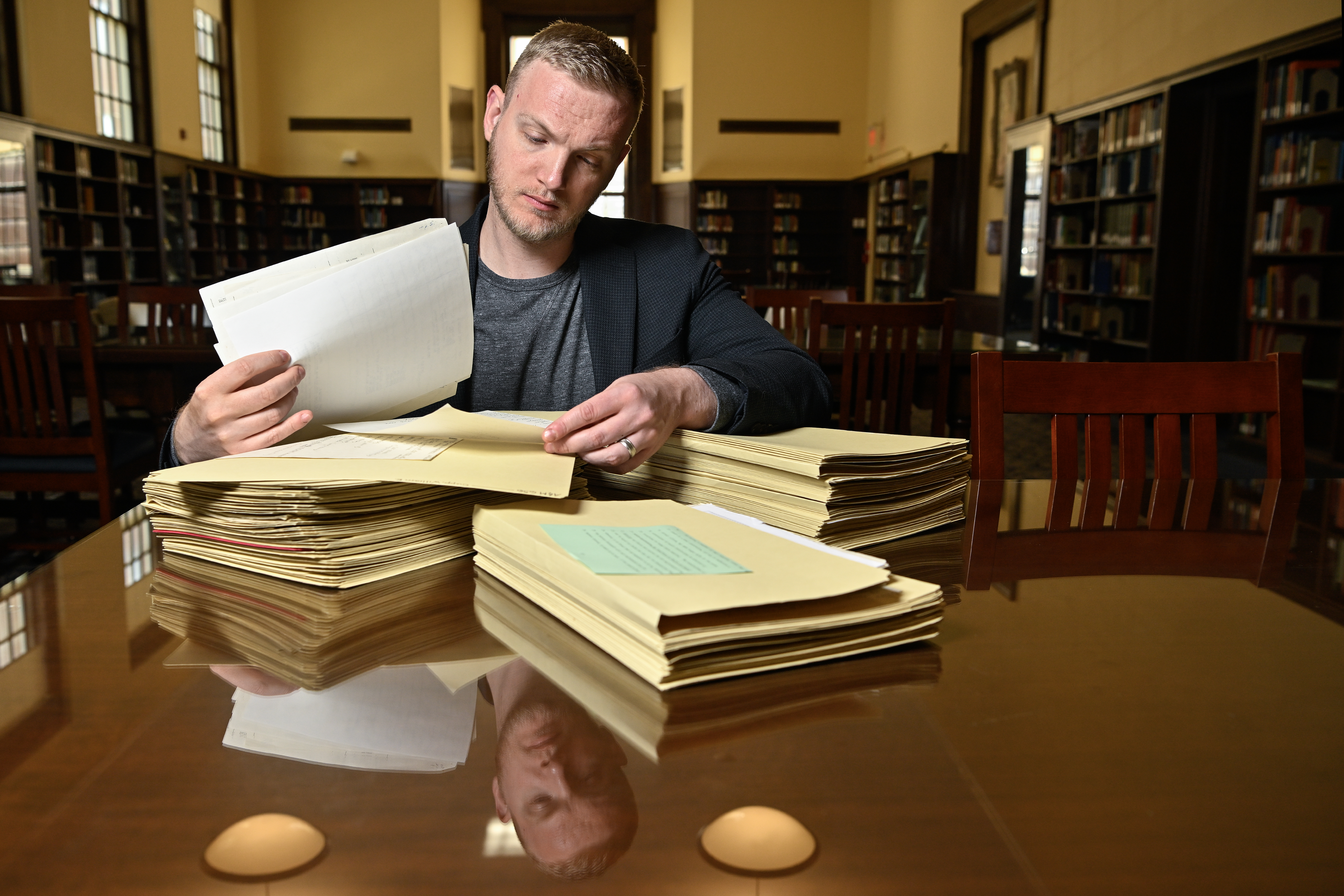
Jonathan King, assistant professor of political science at WVU, will be traveling with graduate students to the Library of Congress in Washington to study and digitize the records, writings, opinion drafts and memos between U.S. Supreme Court Justice John Paul Stevens and other justices. King received National Science Foundation support for the project to better understand how U.S. Supreme Court justices interact behind the scenes. (WVU Photo/Jennifer Shephard)
What happens in the Supreme Court is often behind the scenes. These give us access into how justices interact with each other and how they’re thinking about cases. Jonathan King
A West Virginia University researcher is studying newly released records of private communications between U.S. Supreme Court justices to learn how they interact and relate behind the scenes.
Justice John Paul Stevens donated records, writings, opinion drafts and memos between himself and other justices to the Library of Congress upon his death. To compile and analyze these documents from Stevens’ 1975-2004 tenure on the Supreme Court, Jonathan King, assistant professor of political science in the WVU Eberly College of Arts and Sciences, will be traveling with graduate students to Washington.
“It’s a treasure trove of things like conversations, opinions and general musings,” King said of the files. “What happens in the Supreme Court is often behind the scenes. These give us access into how justices interact with each other and how they’re thinking about cases. Most justices don’t release this kind of data. It goes against court decorum, especially when the other justices are still on the bench.”
This summer, King will bring graduate students to the Library of Congress for eight weeks. They’ll collect data contained in roughly 70,000 documents and use a high-resolution camera to photograph and digitize the information, which can be converted to a machine-readable format.
“We want to train graduate students on data collection as well as the research process,” he said.
The data will then be available to other researchers, journalists, academics and the general public, especially those who lack the ability to travel to the Library of Congress. King plans to create a website dashboard where people can search individual cases and interactions between justices.
When it comes to that data, he’s most interested in precedent-altering cases along the lines of the recent decision to overturn Roe v. Wade.
“We want to look into several major cases where the Court said, ‘Past decisions were wrong,’” he said. “These changes in the law can lead to controversy across the justices. We want to see how the justices interact with each other after those decisions. They have to work with each other. We want to know if and how this collegiality changes.”
Data from Stevens’ tenure may reveal some inner workings of the current Supreme Court bench, too.
“Some of the things that we’ve seen since the Court decision which overturned Roe v. Wade really seem like attacks between justices, something that’s out of the norm. But maybe that’s happened before and it’s just something we’re seeing much more publicly now.”
While these types of communication records are readily available from the executive and legislative branches, King said the Supreme Court is the more secretive branch of government, and data has historically been scarce. He’s particularly interested in the interactions between 1994 and 2005. This was the longest “natural court,” during which there were no personnel changes on the bench. Stevens’ records indicate that, in addition to work-focused discourse, the judges conversed about everyday topics like lunch plans. Likewise, Justices Antonin Scalia and Ruth Bader Ginsberg were known to be close friends who vacationed together, despite their opposing political stances and numerous dissenting majority opinions.
“We’re able to show these justices are normal people,” King said. “Sometimes, justices sitting on the bench during oral arguments would have baseball scores passed to them. These are the fun things that people can see, the actual personality behind the justices.”
The documents may also reveal collegiality between justices could deteriorate after a significant case when the outcome is not in a particular judge’s favor. King would like to know if that effect is a lasting one and if it’s related to the magnitude of a case. He cites the example of Bush v. Gore, which determined the outcome of the disputed 2000 presidential election.
Since that decision, Americans have started to pay more attention to the Supreme Court, King said.
His study will also shed light on day-to-day processes and how they have changed over time. This includes how digital behavior and digital decision making takes place in the 21st century.
King said he hopes to have the repository digitized and machine readable by early 2025.
“Not many academics have gotten a look at this,” he said. “It illuminates a lot of these processes that we don’t know much about, so we’re excited to see what some of those data are.”
The project is funded by the National Science Foundation’s Established Program to Stimulate Competitive Research and the Law and Science Program.
Read more from King in The Conversation.
See this article in WVU Today.
-WVU-
lj/4/1/24
MEDIA CONTACT: Laura Jackson
Research Writer
WVU Research Communications
304-215-1019; Laura.Jackson@mail.wvu.edu
Call 1-855-WVU-NEWS for the latest West Virginia University news and information from WVUToday.